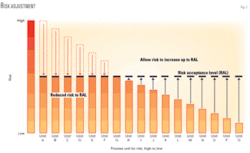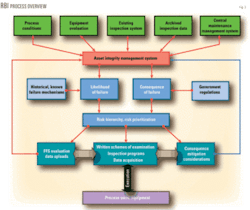Effective risk evaluations prevent refinery shutdowns
An Asian refinery instituted an aggressive, comprehensive risk-based asset integrity management program to reduce substantially unplanned releases, shutdowns, and regulatory fines. Since implementation, the Asian refinery eliminated unplanned releases and reduced unplanned shutdowns by 92%.
During a 2-year period, the Asian refinery experienced a series of unplanned releases that cost more than $200 million in lost product, production shut-down losses, and regulatory fines. In addition, the plant experienced frequent upsets and shutdowns.
In a risk-based inspection (RBI) approach to asset integrity management (AIM), the probability of failure and consequence of failure determine a risk ranking for each system and component. The frequency and intensity of monitoring is then adjusted to achieve an acceptable level of risk.
Adoption of risk-based approaches in the petrochemical, refining, and natural gas industries represents a shift from reactive inspection and maintenance methods (Table 1).
In the long-term, an effective risk-based approach should substantially reduce maintenance and inspection costs because inspection focuses instead on those components and systems most likely to fail and most likely to have significant consequences. In the short-term, however, inspection and maintenance costs can actually increase when the current condition and history of the plant’s systems are scrutinized.
Risk-based approach
At the core of any risk-based approach is developing risk rankings for process units or individual equipment items such as piping circuits, tanks, or pressure vessels. A simple qualitative approach provides a good framework for understanding the more quantitative methodology used in the Asian refinery.
In a qualitative approach, the refiner assesses each plant unit or item and assigns a position within a risk matrix. A 5x5 risk matrix is most commonly used (Fig. 1).
One axis of the matrix represents the likelihood of failure, and the other represents the consequence of failure. During the first stages of RBI implementation, data are collected to rank likelihood and consequence.
Key parameters used to establish the likelihood of failure include:
- The amount and complexity of equipment within the item.
- Damage mechanisms.
- Environmental factors.
- Usefulness of inspection for predicting failure.
- Current equipment condition.
- The nature of the chemical or thermal process.
- Safety design and safeguards.
Key components in evaluating the consequence of failure include the potential for fire or explosion, toxicity, and environmental damages.
For the Asian refinery, we took a more rigorous quantitative approach, collecting corrosion data, damage mechanisms, use histories, process conditions, and other pertinent information for each unit or item.
We then developed possible risk scenarios and calculated a numerical value for each risk scenario RS by multiplying the likelihood LS of failure for each scenario by the consequence CS of failure for each possible scenario. The total risk for an item is then sum of all risks for all of the risk scenarios.
In the quantitative approach, each unit or item has a unique risk value. The inspection program is then designed so that the risk value associated with each process unit or item is adjusted to the same acceptable level of risk (Fig. 2).
For high-risk units or items, the risk acceptance level (RAL) is typically achieved by increasing the frequency of inspection and often the intensity of inspection. Inspection intensity can increase by taking measurements at more locations, or applying additional applicable measurement techniques. For low-risk units or items, the frequency and intensity of inspection are lowered and individual levels or risk associated with the unit or item are increased to the RAL.
Understanding the problem
In many cases, the reason for shifting from a time-based or condition-based inspection program to an RBI program is to reduce long-term inspection costs. For this particular refinery, lower costs were a secondary benefit; the primary reason was the need to eliminate unplanned releases.
Our evaluation identified five major factors leading to releases:
- Unclear goals and objectives for the existing AIM program.
- Ineffective AIM management systems (repeatable quantitative processes with remediation tracking).
- Inconsistent inspection data and limited mechanical and process data (record-keeping issues).
- Unplanned and costly integrity-related outages.
- Mechanical and physical risks due to hazardous material transportation and climatic extremes.
These factors showed that the refiner needed a different inspection approach.
Legislative requirements required a time-based inspection approach. Achieving the desired outcome, therefore, required the refiner to work with legislators so that they could understand how the risk-based approach would actually exceed the safety, reliability, and economic objectives of the legislation.
RBI process overview
The refiner’s goal was a program that represented an industry best practice RBI program. Because of the refinery’s location, this required development of a specific facility inspection scheme that reflected API, British (PSSR), and national protocols, guidelines, practices, and procedures.
Fig. 3 shows the basic components and work flow of RBI implementation for the refinery. We incorporated existing data and programs into the basic AIM system. We evaluated historical and known failure mechanisms for each system and component and established a probability of failure.
We determined the consequences of failure using a combination of factors. Because preventing unplanned releases was the refiner’s primary goal, the main factor was the nature of the chemicals that would be released if containment failure occurred.
The process quantified each risk scenario and determined a risk value for each unit. Once these risk profiles were completed, we developed and implemented written schemes of examination, the inspection program, and data acquisition program.
Because the release and outage problems were well documented at the refinery, this historical data helped identify the units subject to the most common upsets. The inspection program then focused on implementation in the highest-risk units first.
Key tasks
Establishment of any RBI program is difficult. For this program’s implementation, 12 dedicated plant integrity specialists, including engineers, inspectors, and technicians, were employed in the refinery’s inspection organization.
Major specific tasks conducted during implementation of the refinery’s RBI program were:
- Identification of factors contributing to likelihood or consequence of failure:
- –Local environmental factors. These are degradation mechanisms that could affect the loss of containment or overall performance due to local environmental factors (temperature, humidity, etc.).
–Possible failure mechanisms. Each system component has known failure mechanisms and remediation methods.
–Effects of multiple failure mechanisms due to local conditions, such as seismic stress or brittle failure.
- Evaluation of risk to meet safety, environmental, and economic objectives:
- –Calculation and ranking of the total risk at each refinery unit.
–Establishment of the RAL.
- Development of the specific inspection program for each unit to achieve the RAL:
- –Determining which items are critical and essential for monitoring.
–Establishing repeatable, credible, and well-documented inspection methods to enable the refiner to predict corrosion rates and evaluate fitness for service (FFS).
–Inspection and maintenance planning. Assessing FFS outcomes (multidisciplinary engineering analysis), remaining life, turnaround data and extent, and next inspection dates.
- Program implementation:
- –Installation and entry of all data into a commercially available AIM RBI software system for plant components and systems.
–Training of personnel in objectives, policies, and procedures.
- Management of change process:
- –Liaise with national legislators for a shift in time-based inspection constraints.
–Documentation and approval for all inspection process changes.
–Verify that the process is producing the desired results.
Deficiencies
When program implementation began, we identified several key deficiencies within the refinery. Some of these deficiencies were present before the components were initially put into service. These included fabrication defects, segregation, wrong materials of composition, welding flaws, poor fabrication techniques, and incomplete and inaccurate records. We prioritized these deficiencies with respect to risk and developed remediation programs for each.
Deficiencies resulting from the components being on stream were also discovered. Typical of these were generalized corrosion, corrosion under insulation, stress cracking, other metallurgical changes, pressure excursions, and delayed maintenance. As with the other deficiencies, we prioritized these for remediation.
RBI program effects
During a 2-year period in 2004-06, the refinery experienced seven unplanned gas releases. Fortunately, there were no injuries or fatalities associated with these events. The combination of lost product, production shutdown losses, and regulatory fines ranged from almost $100,000 to nearly $100 million. The total cost was more than $200 million.
The 2-year RBI project was initiated at the refinery in 2006. During the first year, we developed the program and started implementing it on the highest-priority units. During the second year, we addressed the refinery’s remaining units.
When we addressed the high-risk items, issues within the refinery began to decrease. Once the program reached its second year, unplanned releases stopped and, therefore, the losses associated with them also ceased. In addition, unplanned outages from all sources were reduced by 92%.
One area where the RBI program was most apparent was on the contingency budget for turnarounds. In 2006, the budget and expenditures were $80 million. For 2007, the actual spending was reduced to $26 million, representing a savings of $54 million.
The authors
Paul F. Schubert ([email protected]) is global sales and marketing manager for SGS Asset Integrity Management Services, Bartlesville, Okla. He has 26 years’ experience in the petrochemical and natural gas industry. Before SGS, Schubert held various technical and marketing management positions with Syntroleum Corp., Monitor Labs, Catalytica, Phillips Petroleum, and Engelhard Corp. Schubert holds a BS in chemistry from the University of Arkansas, Fayetteville, and a PhD in inorganic chemistry from the University of Illinois, Champaign-Urbana. He conducted graduate studies in business administration at San Jose State University, Calif.
Glen Gannon ([email protected]) is operations director for SGS Global Asset Integrity Services, Singapore. He has 28 years’ experience in the oil, gas, and maritime industries. Before joining SGS, Gannon worked with major contractors including BSP, Esso BHP, BP-GUPCO, Stena JVs, ExxonMobil, Oceaneering, Subsea International, and Australian Blue Water Shipping Contractors. Gannon holds a degree from the Australian Maritime College.






